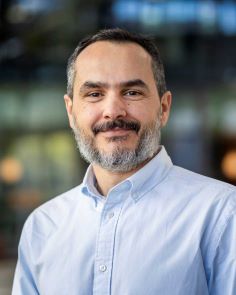Project: Physics-Informed Neural Simulation of Cellular Dynamics
Description
TL;DR: In this project, you will develop a framework for integrating domain knowledge into generative models for cellular dynamics simulations, and apply the method to (synthetic) data of e.g. cancer cell migration.
Project description: Studying the variety of mechanisms through which cells migrate and interact with their physical environment is of crucial importance for our understanding of cell biology. For example, cell migration plays a key role in the interaction between the immune system and implant surfaces, the development of embryos, and the progression of cancer. As experimental capacity in the lab is inherently limited, computational methods have emerged as tools to investigate the stochastic and dynamic nature of cells’ migration dynamics and shapes. However, these methods can be computationally demanding, and rely on hand-engineered ad-hoc models that make oversimplifying assumptions.
On the other hand, deep learning has been gaining traction as a tool for learning approximate simulators directly from data. However, these methods are only in their infancy, and cannot yet accurately model multi-cellular spatiotemporal dynamics. For example, in the context of a so-called cell-sorting simulation, the best method so far suffers from cells moving at slower speeds than expected, as well as cell volumes becoming too small or too large over time [2]. More generally speaking, the distribution generated by the deep generative model noticeably deviates from the ground-truth distribution of the dynamics in question.
One promising way to improve performance of neural simulators seems to be developing methods to inject domain knowledge into the model architecture. To a limited extent, concepts like volume preservation and permutation symmetries have been incorporated into Neural Cell Simulator (NCS) models [1,2], but most research so far into incorporating domain knowledge in neural networks focuses on physics applications [3].
Goals: In this thesis project, you will focus on developing a framework to incorporate domain knowledge into NCS models. Specifically, we will look at modeling formalisms from computational biology, for example the Cellular Potts model [4], and investigate how useful concepts from these formalisms can be embedded in the model architecture. Your method can be evaluated on relatively simple settings like cell sorting, as well as more realistic and complicated settings like the simulation of cancer cell migration [5]. Down the road, an effective framework could have great impact by enabling efficient learning of NCS models from real data, especially in the small-data regime.
Figure 1: Cancer cell migration simulation [5]
Supervisors: Koen Minartz, Vlado Menkovski. Additionally, we can connect you to experts in cellular dynamics simulation and cell biologists if necessary.
Required Skills and Background: Proficiency in Python, NumPy/SciPy and PyTorch, as well as knowledge of and experience with deep generative models (for example from 2AMM10 and/or 2AMU20). A background in biology is not necessary.
References:
[1] Koen Minartz, Yoeri Poels, and Vlado Menkovski. “Towards Learned Simulators for Cell Migration.” NeurIPS AI for Science Workshop, 2022. https://arxiv.org/abs/2210.01123
[2] Koen Minartz, Yoeri Poels, Simon Koop, and Vlado Menkovski. “Equivariant Neural Simulators for Stochastic Spatiotemporal Dynamics.” arXiv preprint, 2023. https://arxiv.org/abs/2305.14286
[3] Rui Wang and Rose Yu. “Physics-Guided Deep Learning for Dynamical Systems: A Survey.” arXiv preprint, 2023. https://arxiv.org/abs/2107.01272
[4] Alexander R.A. Anderson, Mark A.J. Chaplain, and Katarzyna A. Rejniak, eds. “Single-Cell- Based Models in Biology and Medicine.” Chapter II, pages 77-169. Birkhäuser Basel, Basel, 2007.
[5] Kumar, S., Kapoor, A., Desai, S. et al. Proteolytic and non-proteolytic regulation of collective cell invasion: tuning by ECM density and organization. Sci Rep 6, 19905 (2016). https://doi.org/10.1038/srep19905.
Details
- Supervisor
-
 Vlado Menkovski
Vlado Menkovski
- Secondary supervisor
-
 Koen Minartz
Koen Minartz
- Interested?
- Get in contact